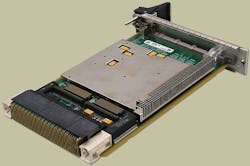New generation of military and industry embedded computing standards takes new stab at cooperation
Among the two newest standardization efforts are the Hardware Open Systems Technologies (HOST) project, and the Sensor Open Systems Architecture (SOSA), says Patrick Collier, lead hardware for open-systems architectures at U.S. Naval Systems Command at Patuxent River Naval Air Station, Md.
Collier briefed industry this week on the HOST and SOSA projects at the Embedded Tech Trends (ETT) conference this week in New Orleans, which is sponsored by the VITA Open Standards and Open Markets industry trade group in Fountain Hills, Ariz.
The HOST program seeks to decompose military embedded systems into functional blocks to ease system design and reuse of embedded computing hardware and software. It's intended to open systems for several different vendors and avoid locking single vendors into large system designs, Collier told ETT attendees.
The SOSA project, meanwhile, focuses on single-board computers and how they can be integrated into sensor platforms, Collier says. It involves a standardized approach on how embedded systems interrogate sensor data to distill actionable information.
The HOST and SOSA projects are relatively new, yet Navy leaders are starting to push HOST standards on Navy programs, as well as on Navy vendors, Collier says.
Creating embedded computing architecture standards and encouraging industry to use them is a commendable endeavor. It does hold the promise of reducing complexity, cutting system costs, and easing systems upgrades and life cycle support over the long term.
Historically, however, a big problem with military-imposed design standards has been enforcement. The military talks about the need for cutting costs through standard design approaches, yet military program managers want unique capabilities, while military suppliers want value-added designs. A commodity approach rarely achieves these ends.
Military design standards, moreover, have been tried time and again, going back decades to Navy efforts in the early 1990s involving the Next-Generation Computer Resources Program (NGCR), the Army's Standard Army Vetronics Architecture (SAVA), and the Air Force's Joint Integrated Avionics Working Group (JIAWG).
Related: Developing a badly needed standard for the use of COTS assemblies in avionics systems
Don't feel bad if you've never heard of these initiatives. They were sort-lived, and had little long-term influence on military systems designs. Technology and industry-backed standards overtook them and quickly made them irrelevant. Today essentially they're forgotten.
The speed of technology presents a formidable challenge to the creation of military and industry design standards. People often criticize how the long duration of military program development often fields obsolete technologies. Standards authorities have to be wary of the same thing: what good is it to standardize on obsolete technology?
It's easy to be cynical about continuing generations of military electronic design standards. Might the HOST and SOSA projects go anywhere? Says Collier himself, "only time will tell."
If we choose to be optimistic, then perhaps the HOST and SOSA projects will have some influence. "There are design intersections where working together will work," Collier says, and I can't disagree. Most likely these programs on their own will have little influence, but perhaps their legacies will help evolve industry attitudes toward working together as a military establishment and its supplier base.
Related: Future Airborne Capability Environment (FACE) Consortium
"People want to work together to make technology stronger for everyone," Collier says. History has shown that companies will work together only so far as competition will allow. People can voice support for standards, but ultimately each company wants to win the contract, sell the most boards, and promote the best solutions.
We have to consider if competition, not collaboration, is actually what creates the best technologies. Maybe this true, but it comes at a price. Competition generally bubbles the best solutions to the top, but it's expensive. U.S. military technology can be the best in the world, but it costs hundreds of billions of dollars every year. Is that sustainable in the long term? Probably not in today's environment.
So that brings us back to cooperation and industry standards. Is this the full answer? Probably not, but maybe it's a start. There's a chance that the culture of the military and the embedded computing industry could be changing, albeit slowly.
When it comes to industry associations and standards bodies, "there is more participation than I've ever seen before," says Jerry Gipper, executive director of the VITA Open Standards and Open Markets embedded industry trade group, which puts the ETT conference together.
"Technology changes, and so do business models," Gipper says. "It may just work this time. I do think we are going in the right direction."
Learn more: search the Aerospace & Defense Buyer's Guide for companies, new products, press releases, and videos
